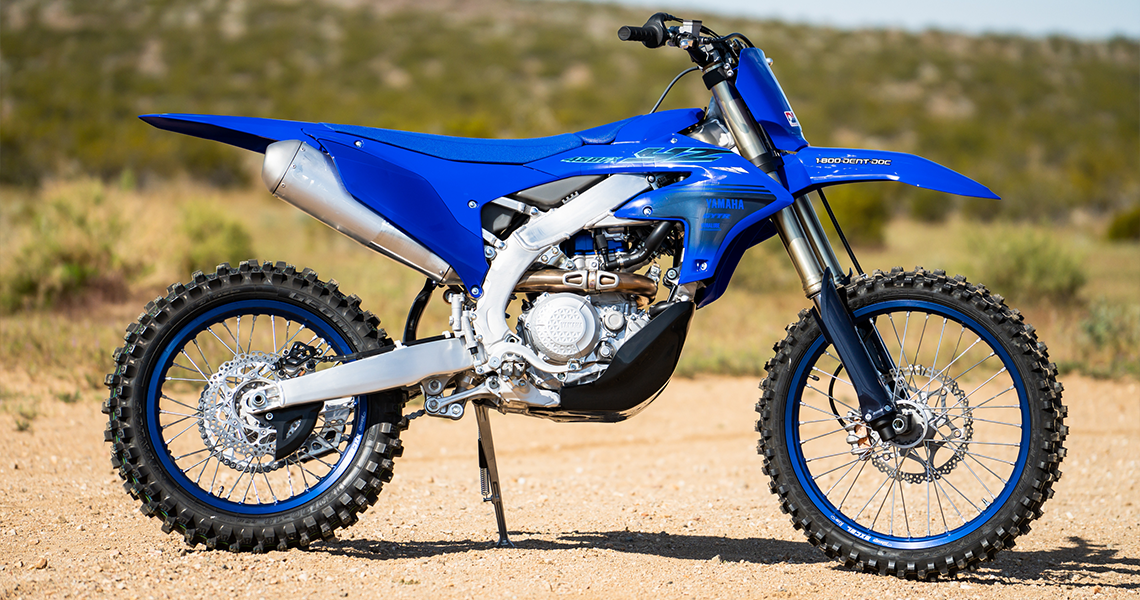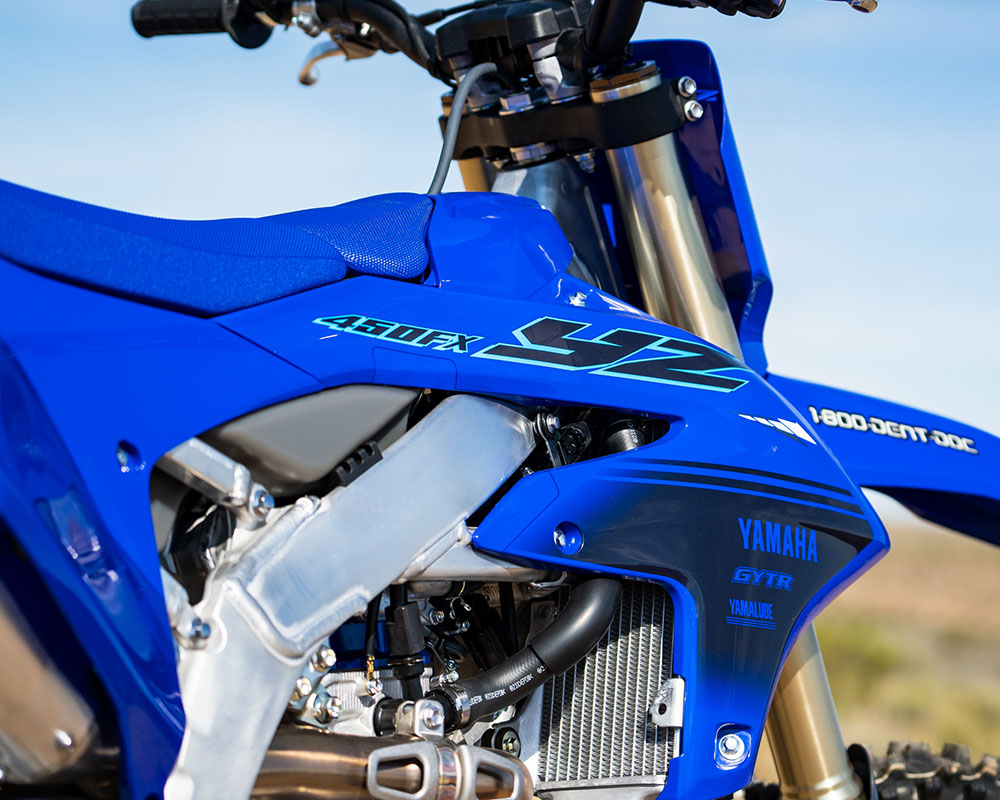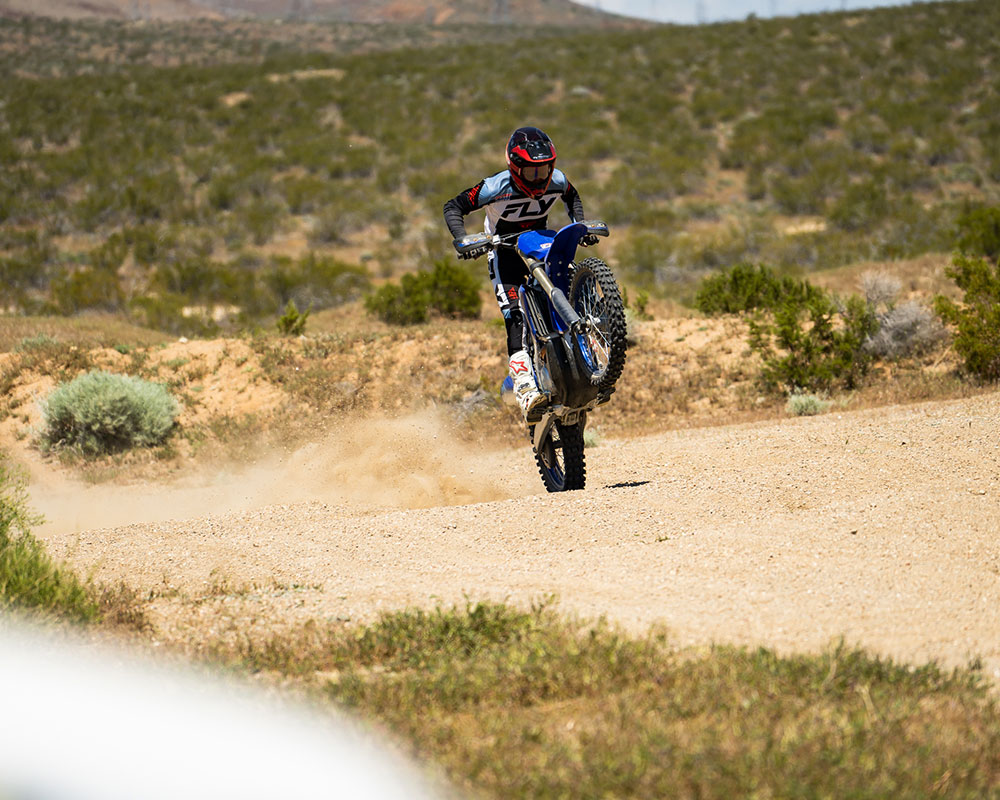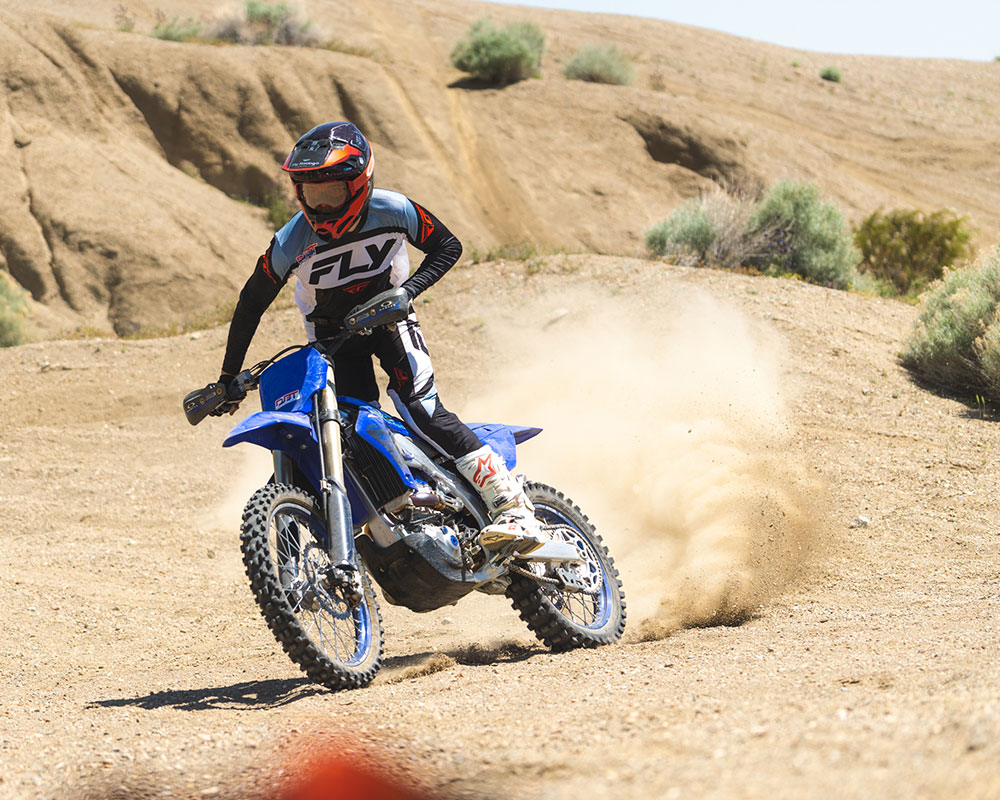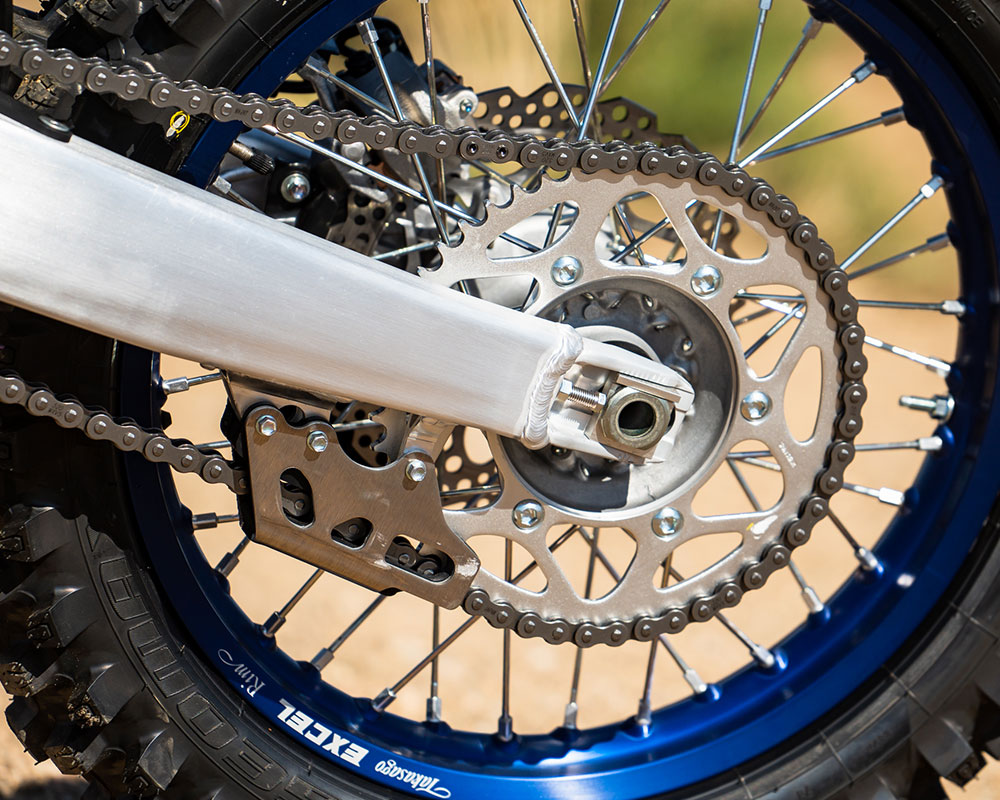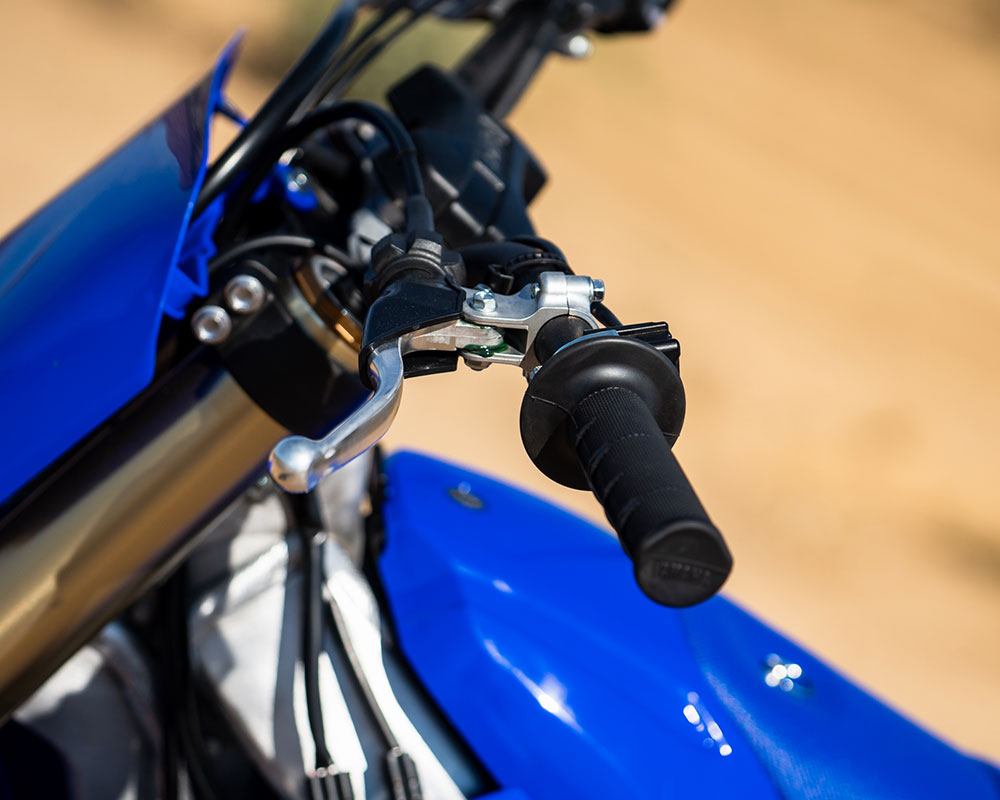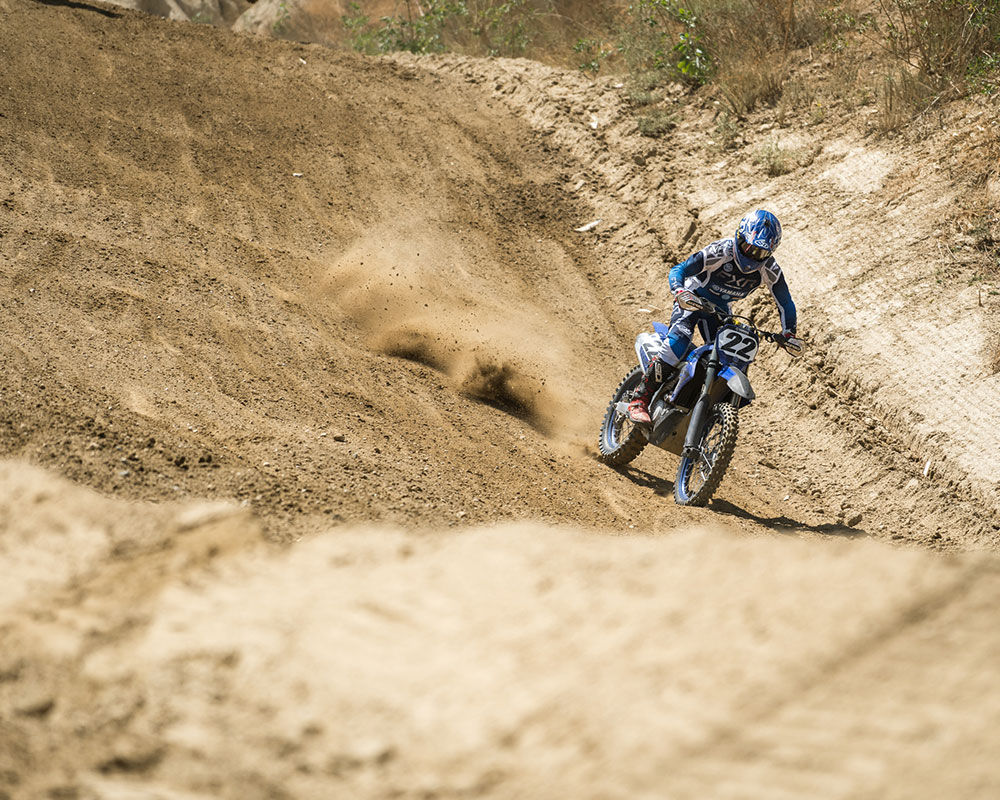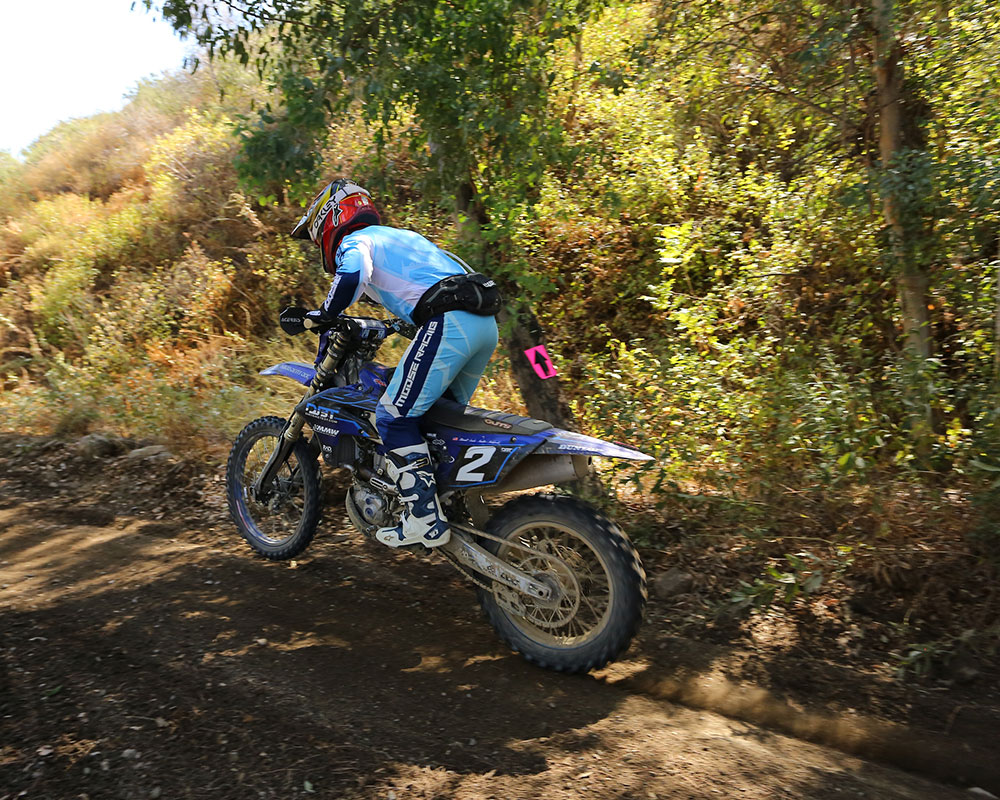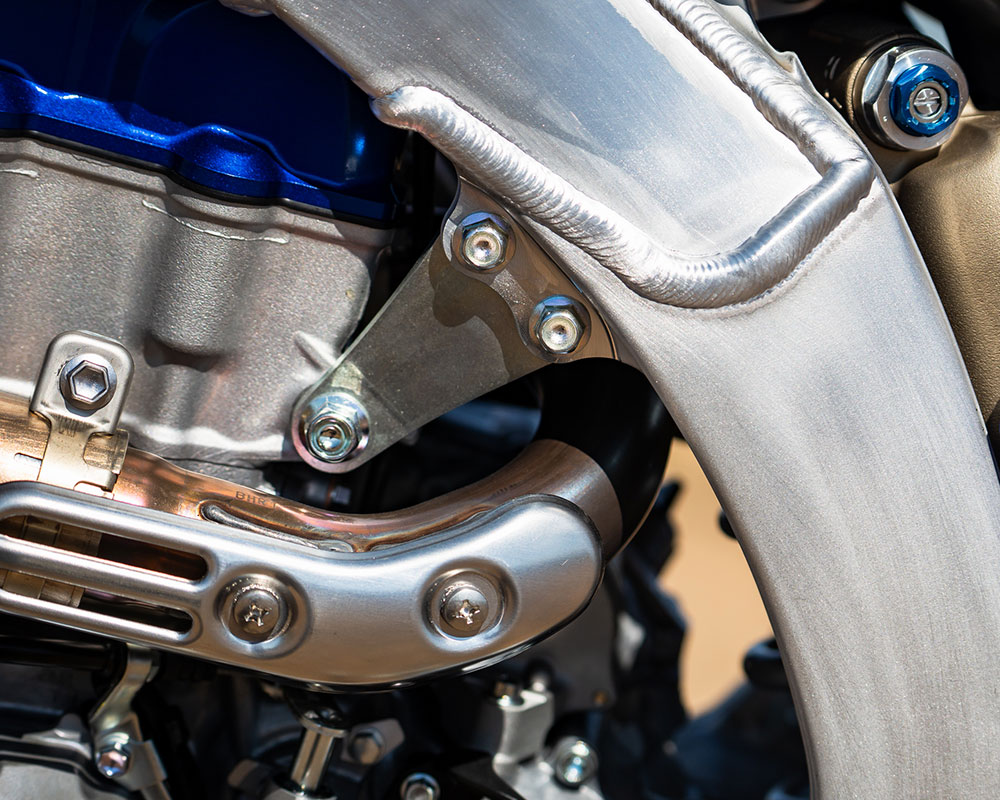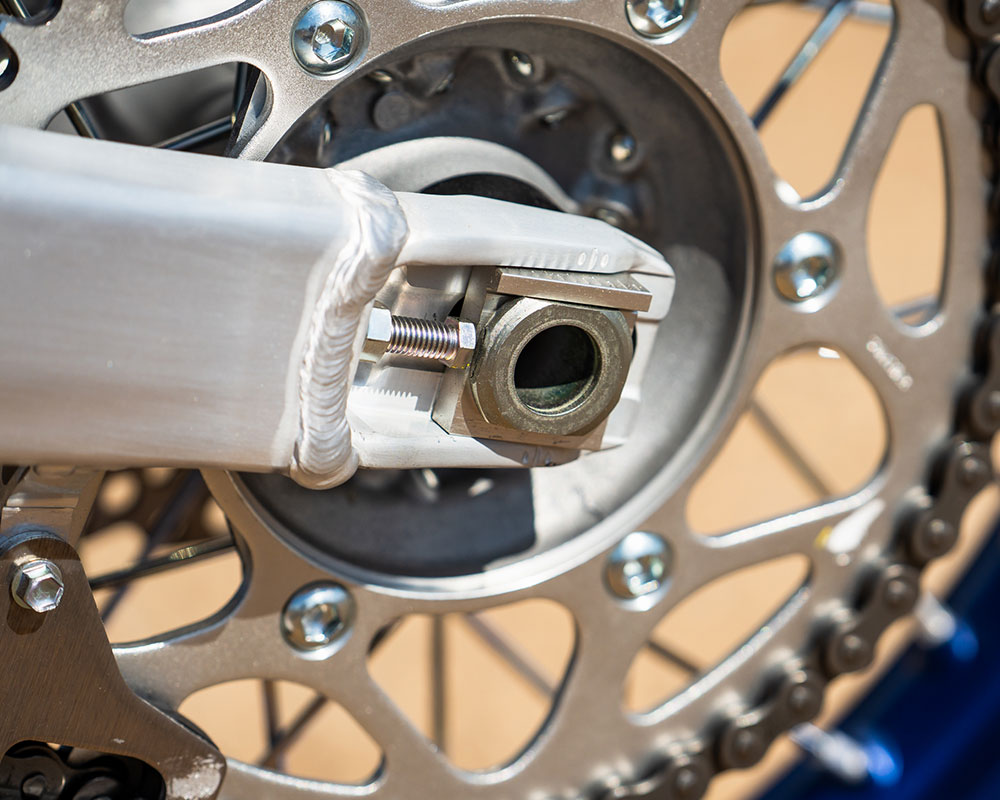2024 Yamaha YZ450FX
All New In Blue
MSRP: $10,199
- Easier to adapt to than the previous generation Yamaha.
- Feels 10-15lbs lighter.
- Tunable engine has all the power you need.
- Stiffer chassis is slightly less comforting.
- Suspension can be too stiff for the average rider.
Introduction
- Yamaha's off-road competition 450cc racer.
Yamaha has taken the “off-road race” market very seriously since the introduction of the FX model lineup in 2015, and nearly a decade later, they continue to push in the growing segment. For 2024, they unleashed an all-new YZ450FX based heavily on the newest generation YZ450F, but with extensive changes to make it suitable for off-road riding and racing. More than just an 18-in rear wheel and a larger gas tank, Yamaha has a dedicated 5-speed wide-ratio transmission, engine mounts, and more to distinguish the bike from its motocross cousin. This is the same bike used by the AmPro Yamaha and Purvines Racing Teams in off-road racing.
Changes
- All new bike from the ground up.
- Updated engine.
- 10mm shorter KYB suspension components.
- New chassis and bodywork.
Changes are abundant for 2024. Some bold new graphics and styling give the YZ a little different flare to the naked eye, but that’s just the start. Under all the new bodywork is a completely redesigned YZ450FX with only a handful of part numbers that return from the previous generation.
Coming off the YZ450F as a base platform, Yamaha started out deep in the tranny by altering the gear ratios. First is super low, second is slightly lower, and fourth and fifth are both higher compared to the motocross model. From there they tuned the ECU to optimize the power delivery for off-road. (But this can be further tuned using the Yamaha GYTR Power Tuner App, including traction control). Two maps are available on the fly, and when the handlebar switch is illuminated, it means this is always a more-mellow map compared to the map when the light is off, yet both are adjustable. The exhaust has also been updated to provide smoother power delivery with further baffles inside the muffler. The clutch engagement has also been optimized for a smoother feel for off-road.
The chassis also received several changes compared to the motocross “F” model. The seat height is 10mm lower (similar seat height as the previous 450FX) and this was achieved by internally lowering the suspension. (Note the overall stroke of the suspension is 10mm less than the “F” model). Lighter spring rates and valving were also altered for off-road racing. The lower engine mounts have been updated and are actually more rigid to help offset the softer suspension settings (more on this later).
From there the YZ-FX received a larger 2.1-gallon fuel tank, O-ring chain, kickstand, and, of course, the 18-inch rear wheel with Dunlop MX33 tires. Other cool features include a skid plate and a low-fuel light illuminated on the handlebar switch.
Although the frame is new, the position of the steering head, shock mount, swingarm, crank, and countershaft have not been altered. The goal was to address all of the small items racers, media, and customers have been asking for, and they did a stellar job doing just that.
First off, the new YZ is lighter on the scales, with a claimed 251 lbs wet weight per Yamaha, ~3 lbs lighter than the previous generation. The chassis is slimmer by two inches in the shrouds, footpegs lower and set back a few millimeters, and the seat is flattened for an improved rider triangle. The bodywork is sleek and all new.
The engine is three pounds lighter and much slimmer (they are now using the 250F rear brake pedal, showing how drastic of a change it is). From the dry sump case design to the new plain bearing crank to the smaller, lighter single-spring steel basket clutch design to the larger yet slimmer transmission, Yamaha went all out.
In addition, the free Yamaha GYTR Power Tuner app has been updated and is more user-friendly, offering simple 1-5 scale options, traction control, and more. However, the option to still create and edit maps like before is still there, with custom tuning of the Fuel and Ignition at certain RPMs/throttle openings. Another cool feature is the GYTR Hydraulic Clutch option out of the GYTR catalog. Though we didn’t get to try it in Florida, the unit bolts on in probably less than 10 minutes if you prefer this over the cable actuation.
Power
- Plenty of power across the range.
- Tunable using the FREE GYTR Power Tuner App.
- Wide-ratio transmission covers a wide range of speeds.
If there is one word to describe the Yamaha engine, it’s WOW! There is certainly no shortage of power on tap out of this 450cc engine. On the west coast, the power is abundant but very usable in faster conditions. Similar to the last bike, though not as pronounced, is a very crisp throttle response at low rpm, which can be unsettling at times if you're not ready for it. As the RPMs build, the torquey engine pulls smoothly through the rev range with a robust mid-range that carries far into the top end.
This engine is pretty incredible in that it has all the power you could ever want which allows you to ride it however you want. Do you like to short shift and ride taller gears at lower RPMs? This engine does it. Do you want to resemble Justin Barcia and feel the rev cut as you race around the trails? This engine does it. It has the torque and low end power of a 450, but the top end of a 350, and it zips through the rev range quickly and freely.
Most bikes that are free revving typically lack torque, and vice versa. However, the bLU cRU have done a good job in getting both out of this bike. Lugging the engine around at slow speeds, we aren’t on the verge of stalling and dealing with a lot of hiccups like we are with some of the other “450FX” bikes that are largely based on the motocross models. Yet, the bike doesn’t have that heavy flywheel effect that feels sluggish through the RPM range.
In our first ride back east at Randy Hawkin’s property, we felt the engine was a bit too much in the tight, muddy confines that we were dropped into. However, this is where the GYTR Power Tuner App comes into play. You can make significant changes to the power delivery with a few clicks on your phone, and now it’s easier than ever. You can still make detailed maps by adjusting the fuel and ignition timing, but now you can also use the sliding scale bar and adjust the power delivery from 1 (mellow) to 5 (aggressive), as well as adjust traction control with a sliding scale.
Like before, the 5-speed wide-ratio transmission is a nice fit on this bike. First gear is very, very low and we rarely ever found ourselves using it. Even taking off from the truck, we’d find ourselves upshifting into second gear when taking off with stock gearing. Second gear is very usable, but third gear is the magic gear on this bike. The engine has the torque to pull it at low RPMs in corners or tighter trails, and with the overrev and top end power, you can pull third gear for a long time. Running taller gears on this engine in tight trails helps smooth the power delivery and has less engine braking, allowing you to flow through the trails easier and more efficiently.
Like the last generation bike, we felt a benefit on changing gearing for two reasons. First, to smoothen out the power delivery and make second gear more usable. Second, and the biggest reason for us, is to smoothen out the chassis feel. We increased gearing from 13/50 stock to 14/52 - 14/53 depending on the rider. Our younger, lighter weight riders who carry more corner speed and momentum could pull the 14/52 and still maintain a usable second and third gear. Our vet riders who are a little heavier and don’t carry the same speed preferred the 14/53 to make third gear more usable in corners and on trails.
The gearing change broadens and smoothens the power delivery, minimizing the hit off the bottom and allows you to pull each gear for a length of time. To us, it makes it more off-road friendly and not so moto like, which most of our riders preferred. More importantly, we feel it really helped the chassis. Going up on sprocket sizes on each end has an effect on the chain torque, and by doing so it helps the bike drive across small acceleration chop. Instead of driving through every square edge bump, it feels as if the bike drives across and on top of the bumps.
We haven’t tried the GYTR hydraulic clutch on this bike, but the cable actuated clutch works very well. It’s a smoother pull and has good engagement and feel to it. It’s one of the better cable clutches on the market that is getting further and further away from the old-school design, yet Yamaha makes it work and it works well. Clutch life is very good on this bike. We went a full 44 hours on the stock clutch before replacing the plates and fibers. We didn’t even “need” to do this, but we wanted a fresh set for the 24 Hours of Glen Helen.
Other than the clutch and oil, we didn’t have to touch a single thing inside this engine in the 68 total hours we put on it, including the 24 Hours of Glen Helen. We replaced clutch and throttle cables at the 40 hour mark as they started to get a little stiff, but that’s as far as we went in terms of engine maintenance. Most oil changes took place between 5-7 hours, aside from the 24 hour where we went the full pull without an oil change and didn’t burn any oil in the process.
Suspension
- Stiffer than normal suspension setup.
- Quality components are easy to setup.
- Chassis balance is critical.
Yamaha has always been on the leading edge of suspension performance. The use of tried-and-true KYB coil-spring SSS components front and rear is a tough combo to beat and this bike is no different. In a first, the stock valving and setup is very accommodating for a fast rider. So much so that our vet riders went in a softer direction from stock, particularly in the fork.
The fork has a stiffer initial feel to it which wasn’t favorable to our vet and slower riders. The stiffer setting is very sporty and playful, but on small chop and in the rocks, it prompts a lot of feedback to your hands and can be a handful. However, as it gets deeper into the stroke under hard braking, there is a slight twitch and nervous feeling in the front end. Most of this is chassis, but we were able to tune some of it out with suspension valving.
The shock is more inline with what we’ve come to expect and that too is very good. The shock setting felt more universally liked for our stable of riders, tracking well under acceleration, staying up in deep whoops, and avoiding hard bottoming.
For most of our time with the bike in stock trim, we softened up the Fork Compression 2-6 clicks depending on the rider and terrain and ran the High Speed Compression in the shock at 1 ⅝ turn out. On a side note, the hand adjusters on the fork compression are a nice touch and easy to adjust.
Chassis setup is rather critical on this bike in terms of sag and fork height. Stock fork height is 8mm, and while it corners very well here, it can be twitchy at high speeds. We experimented with fork height and were able to drop it down to 5mm before it got too harsh feeling in the front end with the stock valving. We always ran the sag at 100-102mm depending on the terrain, but felt getting out of that window gave the bike an unbalanced feel. As we dropped the fork, we felt the need to soften up the fork compression a few clicks.
With valved suspension, our happy spot was 3mm fork height and 100mm of sag. With some valving updates and correct spring rates, we were able to get some initial comfort out of the fork which allowed us to drop the forks in the clamps more. It’s important to note that the fork is 10mm shorter than standard on the FX, and the shock is 3mm shorter internally which is about 10mm of wheel travel. The shorter shock is a mod we did on the previous generation bike and ran 100mm of sag with that shorter shock, so going to that setup straight away on this bike felt familiar.
In our first test with modified suspension, we threw on last year's suspension setup and it really couldn't have worked much worse on the new chassis despite how well it worked on the old chassis. We had to go radically stiffer on both ends to accomodate the new chassis, and it'd be easier to start with stock as a baseline and change valving from there rather than start from a previous year bike.
Chassis - Handling
- Stark difference from the previous generation.
- Increased precision and agility.
- Bump compliance and comfort can be found.
- Feels tremendously lighter on the trail.
The new Yamaha chassis is a big change from the last one. Whether it’s better or worse, that’s for you to decide, but it is different. While it doesn’t offer 100% of the chassis comfort and stability that the old bike did, it still has it in it and can be made more stable and predictable. It’s now much more precise and agile, and feels tremendously lighter than before, much more than the few lbs it lost on the scale.
To start, the bike corners very well. Which to some, can be concerning. However, cornering in any situation is improved whether it's flat corners, ruts, etc. The bike’s ability to cut down in corners or across the track/trail is much improved and you can put the bike where you want it with less effort and more precisely. There is more felt through the rear end of the bike and through the pegs, and it’s something that we changed with aftermarket engine hangars, but the stock hangars are still more than usable.
We “struggled” most with the front end on the bike before we found a few cures. We say struggle loosely as we felt ~90% about it, but under heavy loads there is a slight squirm in the front end on decel. Nothing bad ever happened and it wasn’t something we couldn’t overcome, but it was there and took a while before we cured it.
Something we discovered rather late on this bike is some engine mount modifications. The bike comes stock with a typical engine mount and is paired with an additional plate on the two smaller bolts at the front of the chassis. We were able to increase comfort and bump compliance by removing the additional plate and using the two bolts off of the YZ450F motocross bike, (which can be ordered at Rocky Mountain ATV/MC using our link that supports us and is Part # 187155035925 at just $8.09 a piece) which are shorter to accommodate removing the additional plate. By doing this, this is now the same engine bracket as the stock 2025 YZ450F which was changed for the new year.
Since we didn’t catch this mod until late, we’ll be curious to try it on the stock 2025 bike to see how it works with the stock suspension and if we can be more aggressive on chassis setup, particularly with fork height and removing some harshness when dropping the fork for added stability. You can read more about the mod HERE, but it is a positive across square edge chop, on hard decel bumps, and in rocks where we’ve struggled to find a plush, comforting feel in the front end, even with suspension work. With this mod, we gained a lot of comfort back and took the edge away, eliminating most of the harsh feedback to the hands. One downside is we did lose a touch of front end traction on lean, but the juice is worth the squeeze in terms of comfort gained here. This is a very cheap modification when compared to aftermarket engine mounts (which we have also tried, but so far have come back to this modified stock setting), and one we encourage you to try back-to-back on your next ride day as it only takes a couple of minutes to do (but be sure to torque the bolts to spec for a consistent test).
The new chassis still has one of the better bump absorption characteristics, though it isn’t as good as before. The bike doesn’t have a problem with deflection or kicking, and is still relatively easy to find a good setup. But bump compliance has decreased and you do feel more feedback to the body across the board, albeit it’s still one of the better in terms of comfort at this point.
Typically, and this is more true on 450's than smaller bikes, the more you rev the bike and ride in higher RPMs, the worse the bike handles. This still applies in a sense to this YZ chassis, but we feel it accepts being ridden hard and aggressive moreso than the last bike. More often than not, a 450 will become scary and tough to hold on to when riding in the upper RPM range. This YZ shows less signs of adversity and responds better to being ridden like that.
The overall cockpit and rider ergonomics are much improved with a flatter seat, footpegs in a more neutral position, and a taller seat to peg ratio. Pair that with the range of adjustments you can make with moving the bar mounts around and this bike can be set up for a rider of wide range of sizes. Most preferred the standard #2 setup (bar mounts in the back hole facing forward), but taller riders do appreciate being able to open up the cockpit by moving the bars forward without buying any aftermarket parts.
When riding in tight woods, the new chassis is noticed – and appreciated. It’s responsive, nimble, and more fun and playful to ride as the trails tighten up and speeds decrease. It ultimately feels like it takes less energy to ride in these areas which most found to be a positive.
The brakes on this bike work well. The Nissin front brake can get spongy at times if not bled correctly or if the lever is moved too far in, but the performance is still there. The Nissin rear brake had zero issues, doesn’t fade, and works well so nothing to complain about there.
In our 68 hours with this bike, it held up very well. We had to replace a bent radiator in a crash, and our kill/map switch stopped working after another separate big crash, but aside from that, we had very little maintenance on this bike. We changed the oil every 5-7 hours, and an oil filter every other oil change. As stated previously, we replaced the clutch plates/fibers and cables at 44 hours to freshen it up before the 24 Hours of Glen Helen. After the race, the bike still ran and felt great, not burning oil and still starting lightning quick as it did when it was new.
If you're looking to power lights on this bike, a WR450F stator and flywheel is needed to get a lot more capacity out of it. It's a simple plug-and-play solution and has the reliability and performance of a known OEM part which is a plus. The Stator Part # is BNK-81410-02-00 and Flywheel Part # is BNK-81450-00-00. With these two pieces alone, we were able to power a Baja Designs XL80, a ~75w light, comfortably at several night races which we couldn’t do on the old bike.
Conclusion
- The bike is "normalized" to non-Yamaha riders.
- Very capable off-road weapon that, like the last generation bike, doesn't need a catalog of aftermarket parts.
Yamaha’s YZ450FX has been a staff favorite for a few years now, and what’s best is in the past it has taken very little to really dial in and make it better for you. In fact, the more aftermarket parts you bolted on to the last bike, the worse it got. While we have found there are a few more mods that help this chassis than the last, it can still be largely left alone in comparison to other bikes. The motor, including the exhaust, doesn’t need any changes (unless a spark arrestor is required for your off-road riding/racing), the suspension components are some of the best stock, and the chassis doesn’t need a lot of expensive parts to improve.
One thing that really stands out about this bike is how much more normalized it feels to those who aren’t familiar with Yamaha’s. The old bike had its quirks, mainly in rider ergonomics, that took too long for riders to get accustomed to and hurt their overall perception of the bike if they didn’t spend a lot of time on it. The new bike immediately felt at home to several of our testers who spend most of their time on Austrian and other Japanese bikes. As an off-road race bike, this bike is appealing to the masses and one that really all of our riders have come to like, something that we couldn’t say about the last bike for reasons stated above.
Recent Product Tests
Leave a Reply




